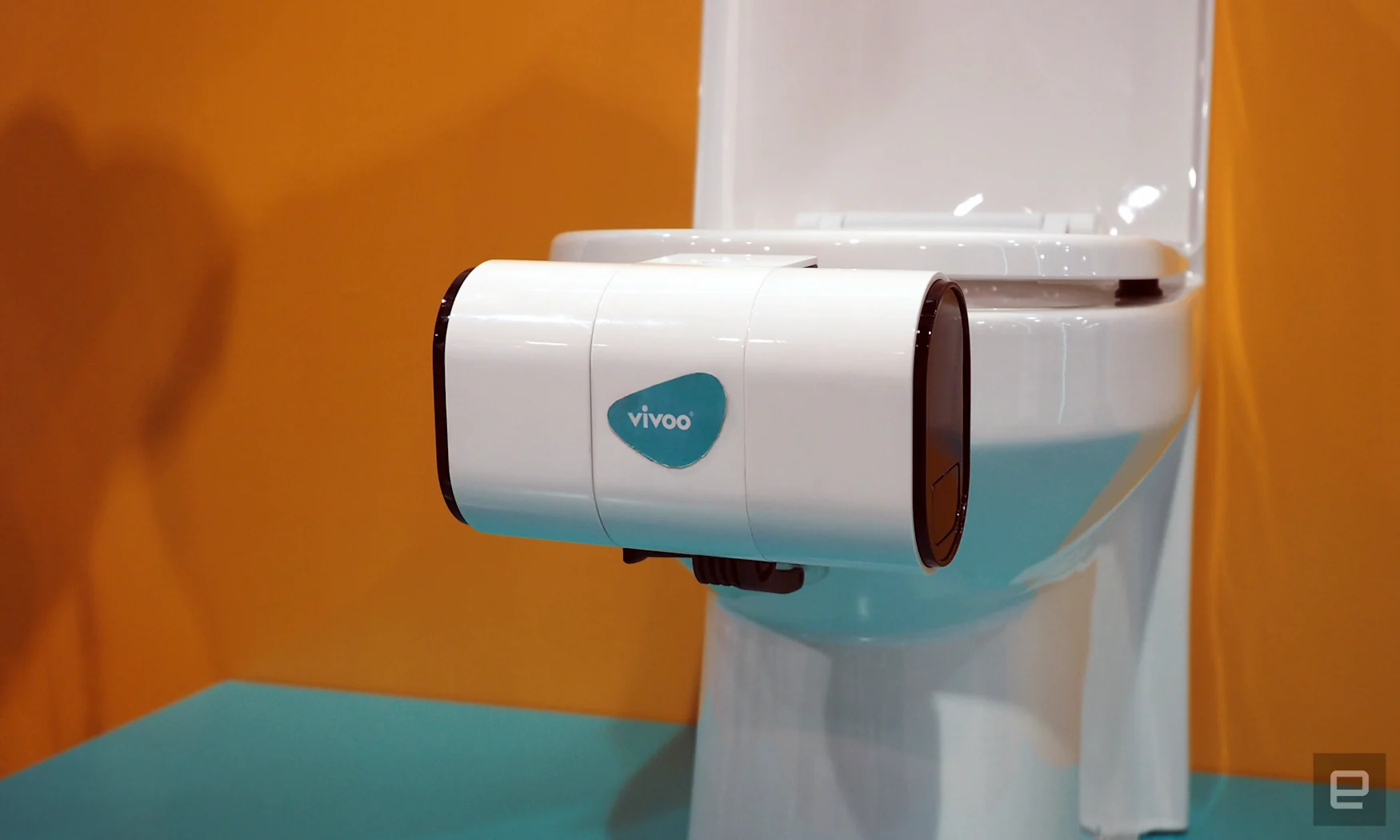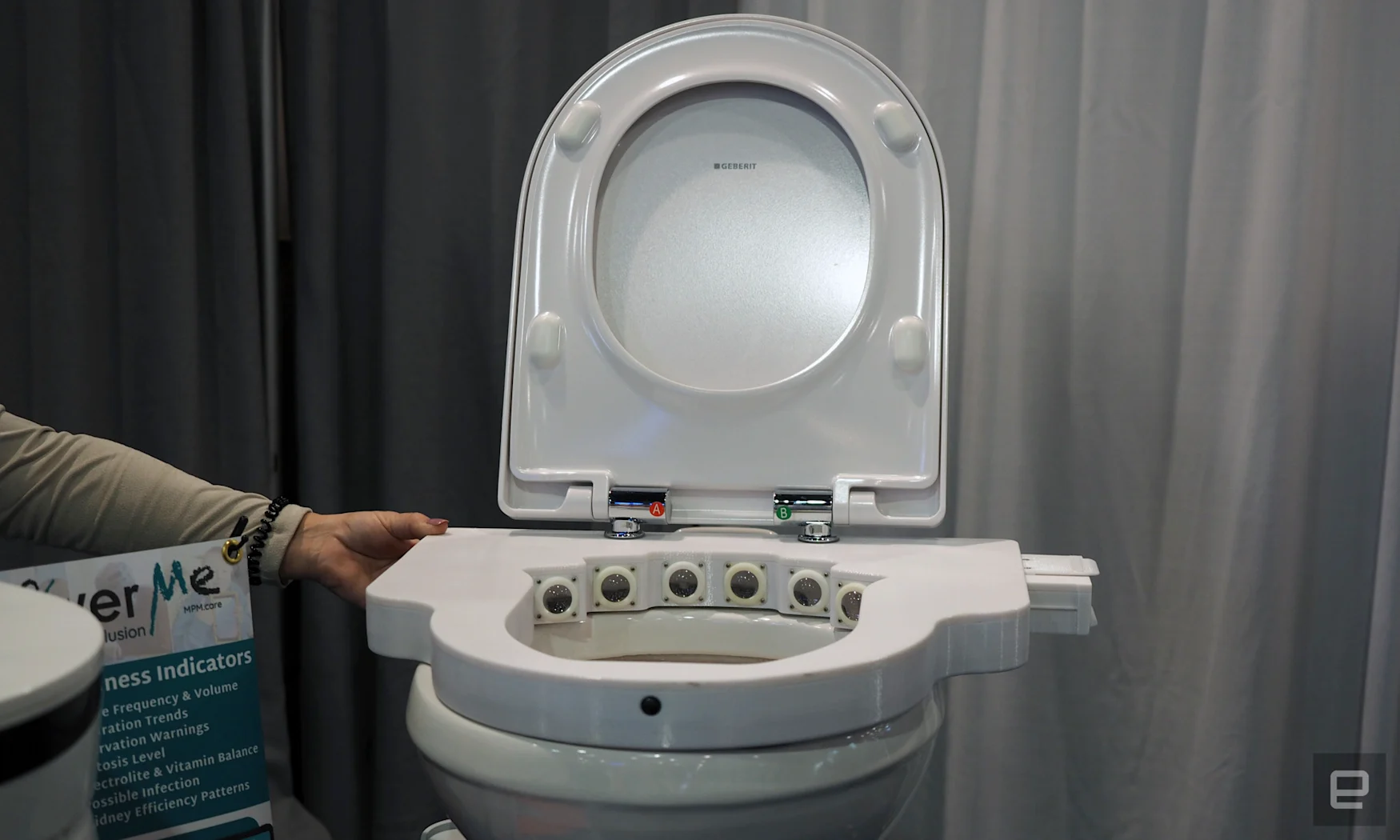One swallow doesn’t make a summer, and I’m not sure if you can count four instances of a product as a trend, but it’s certainly an interesting thread at this year’s CES. At this year’s show, a quartet of companies are showing off urine analysis tools designed to be used at home by the general public. These are positioned as a natural evolution of the fitness tracker, a device you can use to keep an even closer eye on your health and fitness. Most of them are built for your toilet, testing your pee for any number of easy-to-identify maladies. But is this the next great frontier of consumer health tracking? That rather depends on the public’s desire to delve deep into their own bladders.
My cynical take: I suspect the reason we’re seeing these pop up is because the wearables world is now played out. Back in 2019, I wrote that we’d reached the point where there were no new features that could be fitted to a smartwatch, fitness tracker or ring. Or, at least, none that were as valid, effective or accurate as what you now expect every device on the market to offer. Once it was possible to put a single lead ECG in a watch, there were no new health-tracking worlds left to conquer that didn’t involve breaking the skin.
Dr. Audrey Bowden is Dorothy J. Wingfield Philips Chancellor Faculty Fellow, Associate Professor of Biomedical Engineering at Vanderbilt University, and head of the Bowden Biomedical Optics Laboratory. Dr. Bowden tells Engadget that clinical urinalysis is used as a “first line screening for many diseases and conditions such as diabetes and kidney disease,” but added that it can “also play a role in ordinary, routine checkups, such as during pregnancy.”
You may have seen your physician ask you for a urine sample and then stir a dipstick dotted with colored squares of reaction paper into the liquid you’ve just produced. In addition to visually checking urine for cloudiness (an obvious sign of a problem), these squares can run a wide variety of tests as part of this first-line screening process.
Each square corresponds to a different test, looking for factors like pH as well as the presence of blood, or white blood cells. Blood, for instance, can indicate kidney stones or cancer, while white blood cells are a clue your body is fighting an infection. If there’s excess glucose in the urine, it’s likely that diabetes is the culprit. Ketones would indicate ketosis, nitrites could indicate bacteria in the urinary tract, and so on.
Dr. Bowden added that for many conditions, urinalysis is not a “definitive diagnostic, but rather serves as an initial prompt to perform a more complete investigation.” And that since the clinical procedure has been to test for urine when there’s already evidence of a problem, it’s not clear how effective daily testing can really be.
A medical professional I interviewed, who requested anonymity for fear of compromising their professional standing, expressed skepticism both about the accuracy of these tests as well as their utility. They said that if people were running tests at home on a regular basis, it runs the risk of providing hypochondriacs with another reason to clog up care centers.
Dr. Shubha K. De (MD) is a Urologic surgeon who is presently working on a PhD in biomedical engineering. He raised a concern that, in primary care facilities, medical staff know how to validate the data they’re presented with, and to screen out false positives. This may not be the case in an at-home setting, and added that the accuracy of some tests vary wildly — a dipstick test to identify a bladder infection is roughly 80-percent accurate, but to diagnose bladder cancer, it falls to just 3 percent.
The most talked-about gadget at CES is surely Withings’ U-Scan, which even Jimmy Kimmel joked about in his opening monologue on Thursday. Given that Withings is already such a big name in the health-tracking world, it’s little surprise that it’s hogged the attention. The company showed off a device that sits on the dry part of your toilet bowl, and samples some of your trickle as you pee. Once that fluid is captured inside the device, it runs a sample through a microfluidic cartridge (with reaction paper) and uses a reader to look at the result. Once completed, the results are sent to your phone, with suggestions on what you might do to improve your health.
When it’s eventually released, U-Scan will offer a cartridge for menstrual cycle tracking, as well as one to monitor your hydration and nutrition levels. It’s this latter cartridge I tried during my time in Vegas this week, and it looked at the pH of my urine as well as the specific gravity (relative density) of my pee. But the company promises that it will eventually be able to identify nutrient levels, fat metabolism, ketones and quantities of vitamin C.
Both of these have raised red flags with professionals who are concerned that these analyses don’t suit a one-size-fits-all model. Dr. Bowden said that menstrual cycle tracking based on “‘normalization’ curves may have been developed with too narrow a demographic to capture all interested users.”
Dr. Bowden was also resistant to the idea that nutritional information can be extracted given clinical urinalysis doesn’t offer data about those markers. She said urine samples don’t really “provide reliable information over a given time window,” and added that a “daily analysis of food nutritional content may be a stretch.” Although she did say that it may be possible to detect “accumulated nutritional deficits.”
Dr. De, however, says that it may be possible to extrapolate nutritional information back to a person’s diet using urine analysis. They said that physicians currently ask patients to run 24-hour urine collections, and that fluid is then examined for specific substances — like uric acid — to make inferences on dietary intake. “This is not always perfect, and currently needs some correlation with one’s diet history,” but added that it’s plausible to imagine that, with a “user friendly app and some AI” that it could work well.
Withings is looking to develop more clinical tests, and has said that it’s already working on a way to screen for bladder cancer markers. It’s here that my source who asked not to be named feels would offer real value to groups who are at risk of the disease. They said that a targeted monitoring program may help identify instances of the cancer early, which should dramatically increase survival rates.
Daniel Cooper
Korean company Yellosis graduated from Samsung’s startup incubator some years ago, and already produces the Cym Boat personal urine testing kit. Cym Boat offers a small stick with reaction paper squares, which you then stand in a boat-shaped piece of card lined with color-calibration squares. Take a picture on your smartphone, and you’ll be able to look at the blood, protein, ketones, pH and glucose levels within your urine.
At the show, it also showed off its next-generation product, Cym Seat, which uses a metal arm to hold a paper stick under a person as they pee. Once completed, it slides the strip in front of an optical scanner, and after a minute, the results are pushed to your phone. But this device, which is expected to launch by the end of 2023 and cost around $1,000, automates the existing process rather than adding anything new.

Daniel Cooper
Similarly, Vivoo, which also offers a reaction-paper stick which can be analyzed by a smartphone app, is building its own toilet-mounted hardware, which pushes a pee stick into the toilet bowl and then pulls it back in once it’s collected a urine sample. An optical scanner then reads the reaction squares before depositing the stick in a collection bin for disposal later.

Daniel Cooper
Rounding out the group is Olive, which is taking a dramatically different tack. The device harnesses spectroscopy rather than reaction paper, with hardware that sits under your toilet seat, and a bank of LEDs flashing toward rear-mounted photodiodes. The potential for such a technology is far greater than reaction paper, and there are some studies that have pointed to being able to identify infection with it.
Olive is presently being used in a handful of locations in the Netherlands, including an assisted living facility. Co-founder Corey Katz told Engadget that one of the most surprising uses for the technology was for personnel to keep accurate records of patient bathroom visits. Katz added that work is presently under way to find a way to measure levels of protein in urine to identify instances of preeclampsia.
The company says that there’s a broad number of conditions that spectroscopy could be used to test for. This includes hydration and ketosis all the way through to stress, creatinine levels and electrolyte balances. The hope is that a finished version of the hardware will be ready to go by the end of 2023, although it’ll only be sold to business customers.
There are issues, including around data security, especially for menstrual cycle tracking in countries like the US. Companies that could expose fertility data will need to be mindful of the legal context that is presently in place post-Roe.
If Dr. De has a final concern, it’s a worry that these at-home devices will encourage patients to take medical matters into their own hands without the supervision of a physician. “If [urine analysis systems] direct you to take supplements which jeopardize pre-existing medical conditions,” for instance, “then it could be quite dangerous.”
Of course, there are other things that independent experts (and journalists) will need to test when these devices make it out into the real world. Dr. Bowden raised concerns that urinalysis tests can be “impacted by a number of external factors,” which clinical settings make an effort to control for. Will these devices be accurate enough for the jobs they’ve been bought to do? And will the conclusions they provide be worthwhile? There’s a lot to work through before these products become ubiquitous in bathrooms around the world.
All products recommended by Engadget are selected by our editorial team, independent of our parent company. Some of our stories include affiliate links. If you buy something through one of these links, we may earn an affiliate commission. All prices are correct at the time of publishing.

